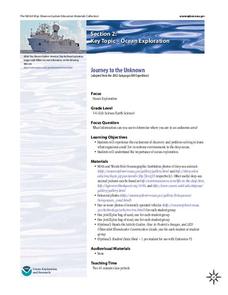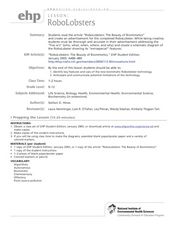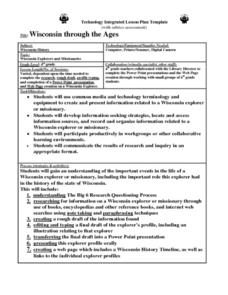Alabama Learning Exchange
Abundant Area
Explore the relationship between perimeter and area. Learners input the area and perimeter for shapes on the Shape Explorer website, solve problems using geoboards, complete a worksheet, create a PowerPoint presentation, and take an...
Curated OER
A Differentiated Way through Think Dots
Learners examine reasons that led people to explore, identify "West" as defined following Revolutionary War, explain importance of finding natural resources, develop time line of dates and events leading up to Lewis and Clark Expedition,...
Houghton Mifflin Harcourt
Voyagers: Challenge Activities (Theme 5)
Young voyagers face the challenge of the wide dark sea, travel with Yunmi and Halmoni, and even get trapped by the ice as they explore the reading selections offered in these enrichment activities designed for the Houghton Mifflin...
NOAA
Journey to the Unknown
What's it like to be a deep-sea explorer? Tap into the imaginations of your fifth and sixth graders with a vivid activity, the second part of a six-part adventure. Learners close their eyes and submerge themselves in an expedition aboard...
National Geographic
Ocean Exploration
Dora, Dora, Dora, Dora, Dora! This may be your little ones' best guess as to what it's like to be an explorer! Give them a deeper understanding with this compact examination. A four-minute video introduces them to Robert Ballard, the...
NOAA
Wet Maps
How do oceanographers make maps under water? Junior explorers discover the technologies and processes involved in creating bathymetric maps in part three of a five-part series designed for fifth- and sixth-grade pupils. The lesson...
NOAA
History's Thermometers
How is sea coral like a thermometer? Part three of a six-part series from NOAA describes how oceanographers can use coral growth to estimate water temperature over time. Life science pupils manipulate data to determine the age of corals...
NOAA
What Killed the Seeds?
Can a coral cure cancer? Take seventh and eighth grade science sleuths to the underwater drugstore for an investigation into emerging pharmaceutical research. The fifth installment in a series of six has classmates research the wealth of...
Curated OER
Animated Snowman
Students produce a web page with an animated snowman using DHTML and JavaScript. The finished project must work correctly in Netscape 4.7 and Internet Explorer 5.0 on both Mac and PC.
Curated OER
Ocean Exploration: Shapes and Patterns Under the Sea
So many shapes in our vast oceans. Young explorers can discover new shapes in a variety of ways in this lesson. One way is having free exploration with a pattern shape kit handed out by the teacher. Another is by viewing a video, Ocean...
Curated OER
Genome: The Secret of How Life Works
What do you have in common with a fruit fly? About 60 percent of your DNA. The resource, divided into two units, is intended for grades four to eight and another for high schoolers. Both units include eight lessons covering the genome as...
San Francisco Symphony
Adding Music to Oklahoma History
To better understand Oklahoma state history, learners will use a website to find a song that supports or represents aspects of Oklahoma's history. They'll write three sentences defending their choice, and then they will create...
Smithsonian Institution
The Sounds of an Island: Jamaican Music for the Classroom
Introduce young explorers to the music and history of Jamaican culture through game songs and dances. As a bonus, class members get to play simple songs transcribed for the recorder.
Curated OER
Robo-Lobster
Introduce environmental science or engineering explorers to different forms of sampling. They read an article about "Robo-lobsters," lobsters being studied to help design robots that can used to sniff out pollution in ocean waters. The...
National Park Service
I Have Five Senses!
Which sense helps you feel a pinecone? Or smell a rose? Three worksheets prompt explorers to think about their five senses in various situations.
Curated OER
Wisconsin Through the Ages
Fourth graders research Wisconsin explorers. They analyze sources for information related to a Wisconsin explorer or missionary. They create a rough draft and edit and type a final draft including a profile of their explorer and...
Curated OER
Voyages of Discovery
Young scholars create individual "travel logs" for a world explorer whom they studied in history class. This lesson is an interdisciplinary activity for the Language Arts and History classroom.
Curated OER
I'll Trade a Ponce de Leon for a Columbus...
Third graders research the discovery of the Americas by various explorers. They create a multiedia presentation about an explorer of their choice including their motivations, obstacles, and successes. Their explorer information will be...
Curated OER
Exploring with Cartography
Students are introduced to the topic of cartography. Using the internet, they research the paths and goals of early explorers. They create a PowerPoint presentation of the information they collected. They also develop a...
Curated OER
Explore Your World--Geography Takes You Places
Students examine how the world around them is constantly changing. In groups, they travel between centers in their classroom to role play the role of explorers in Washington D.C. They share their experiences with their classmates and...
Curated OER
Adventures in Exploration
Fifth graders research major explorers in history using their textbook and then create a timeline using Timeline Software. Students participate in class discussions and write an essay about the explorer they researched.
Curated OER
5th Grade Sample Unit Sheet
Fifth graders read in any textbook, about the French, Spanish and Dutch explorations. They choose any 5 questions from the back of the chapter to answer. Students listen to the tape and follow along in "America will Be." They watch a...
Curated OER
Length, Perimeter, and Area
Students explore the concepts of length, perimeter, and area. In this math lesson, students use Shape Explorer to practice finding length, perimeter, and area.
Curated OER
Guided Reading Organizer for Chain Reaction
The class uses Chain Reaction, a magazine, to build a better understanding of Latin and Greek roots found in scientific vocabulary. They use two attached worksheets to help them read a scientific article, using visual clues and their...

























